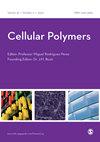The effect on the surface activity and the structure of SPI caused by cleavage of disulfide bonds and by subsequent glucose modification
IF 1.9
4区 医学
Q4 MATERIALS SCIENCE, BIOMATERIALS
引用次数: 0
Abstract
The main purpose of this study was to investigate the effects on the molecular structure and the properties of soybean proteins isolate (SPI) after two modifications: (1) peracetic acid oxidative cleavage of its disulfide bonds and (2) the subsequent addition of covalently bonded glucose to the SPI containing the cleaved disulfide bonds. An appropriate amount of peracetic acid will be capable of enhancing the surface properties of SPI significantly; however, excessive oxidation can obtain undesirable results. When the concentration of peracetic acid was 0.4%, following by 35.5% of the disulfide bond cleavage, compared with those of natural SPI, the foaming capacity (FC), foaming stability (FS), emulsifying capacity (EC), and emulsifying stability (ES) of oxidized-SPI were increased by 82.0%, 65.8%, 58.5%, and 41.5%, respectively. The surface activity of oxidized-SPI could be promoted by glucose modification, and the FC, FS, EC, and ES of oxidized-SPI have further risen to 146.8%, 96.0%, 131.4%, and 40.3%, respectively, after the further glucose modification. Particle size measurements showed bimodality for the SPI that was modified with glucose with a portion of smaller sizes seen. Fluorescence spectroscopy and circular dichroism measurements demonstrate that extensibility increases; flexibility is enhanced; and glycosylation occurs more readily due to the oxidation of SPI. When grafted with glucose, these oxidized soybean protein products produce more ideal foaming and display better emulsification properties.二硫键断裂和随后的葡萄糖修饰对SPI表面活性和结构的影响
本研究的主要目的是研究两种修饰对大豆分离蛋白(SPI)分子结构和性能的影响:(1)过氧乙酸氧化裂解其二硫键,(2)随后在含有裂解二硫键的SPI上加入共价键的葡萄糖。适量的过氧乙酸能显著提高SPI的表面性能;然而,过度氧化会产生不良后果。当过氧乙酸浓度为0.4%,二硫键裂解率为35.5%时,与天然SPI相比,氧化SPI的发泡能力(FC)、发泡稳定性(FS)、乳化能力(EC)和乳化稳定性(ES)分别提高了82.0%、65.8%、58.5%和41.5%。葡萄糖修饰可提高氧化- spi的表面活性,经葡萄糖修饰后,其FC、FS、EC和ES分别提高到146.8%、96.0%、131.4%和40.3%。粒径测量结果显示,用葡萄糖修饰的SPI具有双峰性,其中看到了较小尺寸的部分。荧光光谱和圆二色性测量表明,可扩展性增加;灵活性增强;由于SPI的氧化,糖基化更容易发生。与葡萄糖接枝后,这些氧化大豆蛋白制品产生更理想的泡沫,并表现出更好的乳化性能。
本文章由计算机程序翻译,如有差异,请以英文原文为准。
求助全文
约1分钟内获得全文
求助全文
来源期刊

Cellular Polymers
工程技术-材料科学:生物材料
CiteScore
3.10
自引率
0.00%
发文量
9
审稿时长
3 months
期刊介绍:
Cellular Polymers is concerned primarily with the science of foamed materials, the technology and state of the art for processing and fabricating, the engineering techniques and principles of the machines used to produce them economically, and their applications in varied and wide ranging uses where they are making an increasingly valuable contribution.
Potential problems for the industry are also covered, including fire performance of materials, CFC-replacement technology, recycling and environmental legislation. Reviews of technical and commercial advances in the manufacturing and application technologies are also included.
Cellular Polymers covers these and other related topics and also pays particular attention to the ways in which the science and technology of cellular polymers is being developed throughout the world.
 求助内容:
求助内容: 应助结果提醒方式:
应助结果提醒方式:


